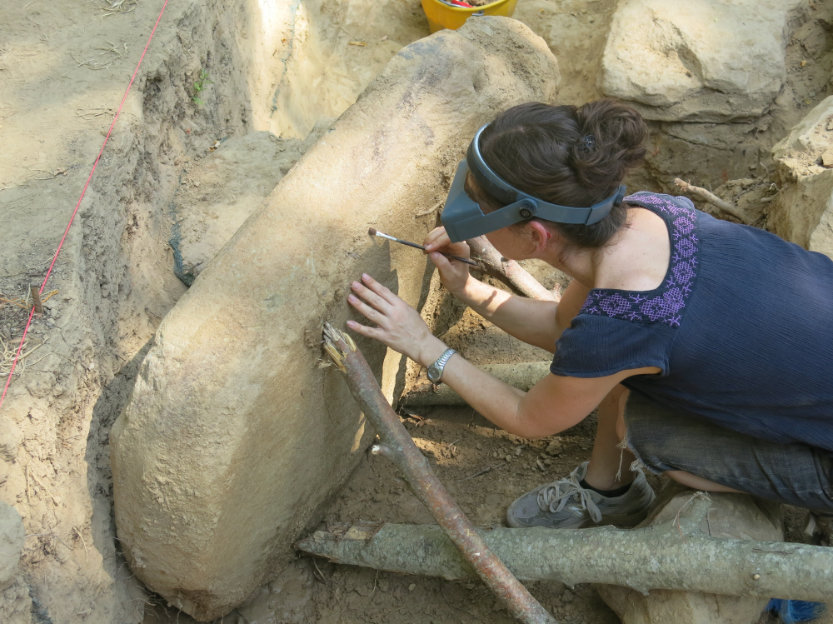The team at Conserv is growing! This week we are introducing: Allison Lewis. She is our new Conservation Liaison and an objects conservator. Before joining Conserv, Allison worked for seven years at the Oakland Museum of California, where she cared for fine art, natural science, and historical collections. Allison has also worked on multiple archaeological excavations, and graduated in 2008 from the UCLA/Getty Conservation Program in the Conservation of Cultural Heritage. (Banner Photo Credit: Mugello Valley Archaeological Project)

Conservation Liaison Allison Lewis
What is your role on the Conserv team?
As a Conservation Liaison, I help build our connections with the cultural heritage community. I meet with collections professionals at museums, libraries, galleries, archives and other institutions to learn how they currently perform environmental monitoring, and what kind of environmental monitoring and IPM systems they dream about having!
I draw upon my years of real-world experience with data loggers, pest management, and other preventive conservation challenges to provide informed support for each customer’s individual situation, and contribute to Conserv’s product development.
I love helping collections of every sort get access to tools that will save time and improve preservation efforts.
What is your experience with collections / museums?
I have worked for over ten years as a museum and archaeological excavation conservator, and consulted for other collections and private individuals. As a museum conservator, I have worked on many exhibits and loans, and have undertaken in-depth work on IPM, pesticide residue detection, and public engagement. At the Oakland Museum of California, I coordinated conservation for the natural history collection, oversaw the materials testing (Oddy testing) program, studied which art protection measures were most effective with visitors, and helped to develop frameworks for working with contemporary artists. As the head conservator at the Mugello Valley Archaeological Project’s Poggio Colla excavation, I worked with archaeologists, graduate students and undergraduate field school students to excavate, document, study, and preserve ancient Etruscan artifacts.
What excites you about Conserv?
It’s so exciting to (finally!) use something designed specifically for us collections professionals and the work that we do. Conserv’s thoughtful product design and commitment to continually improving the products based on customer feedback are really gratifying. As someone based in the backyard of Silicon Valley, California, it’s also exciting to see the company apply 21st century technology to the cultural heritage sector in a meaningful, sustainable and user-friendly way.
Conserv’s sensors and software address so many of the frustrations that we have all felt…no more trudging endlessly between data loggers for manual downloads, or spending hours trying to interpret climate data and wrangle it into a shareable form. Conserv’s focus on people is also really exciting. Conserv is unique in its dedication to excellent customer service, and its mission of making great preventive conservation tools available to everyone.
It feels so good to help hardworking preservation professionals get back some time and understand their environments better.
Where do you see the company going in the future?
There are so many intriguing avenues to explore. Some include:
-
- Continue to expand monitoring capacity. Conserv now offers cold temperature sensors for freezer monitoring, rugged outdoor sensors for hyperlocal weather data, and leak detection sensors to prevent water damage. It will be exciting to develop new LoraWan sensors that can monitor for air pollutants/pH, dust, etc., and perhaps specialized processes like loans and transit.
- Create light exposure estimation/calculation tools to help collection stewards model potential light damage for sensitive objects, and communicate with other stakeholders about cumulative light exposure over time.
- Utilize data science techniques to learn more about the relationships between environmental datasets and help the heritage field collectively work towards climate sustainability goals.
- Make it easier to incorporate environmental and pest data into collection management systems to create a more complete record for each object.
- Foster community knowledge exchange by facilitating local data sharing relationships, such as for pests in a given geographic area.
The great thing about Conserv is that our user community will steer where the company goes. I can’t wait to hear your ideas!




